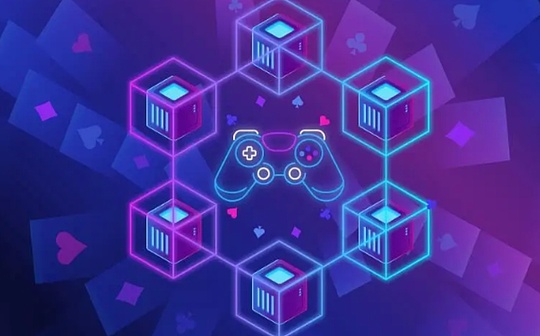
Author: CaptainZ Source: X, @hiCaptainZ
For a long time, when we talk about chain games, they are all based on smart contract platforms such as ETH.The reason is also obvious, either take the GameFi route with asset-based links or take the full-chain game route with status-based links.No matter which route, using smart contracts is the easiest way to implement it.However, the emergence of inscriptions has led to the non-smart contract platform BTC ecosystem combining with indexers to produce another different technical implementation method.This article will give a technical summary of the exploration of BTC ecosystem games, metaverse and independent world, and let’s see how inscriptions and chain games are combined.
Another implementation of full-chain games
For a typical GameFi game with asset-on-chained assets, whether it is issuing NFT or FT tokens, a smart contract platform is still the best choice, without any trouble.So can the full-chain games that were popular last year be put into BTC chains?This sentence sounds strange at first: the definition of games on the entire chain is to write both game logic and assets onto the chain (logic is written to the smart contract virtual machine and assets use smart contracts to issue coins). Since you have all the smart contract functionsNo, how to do it?
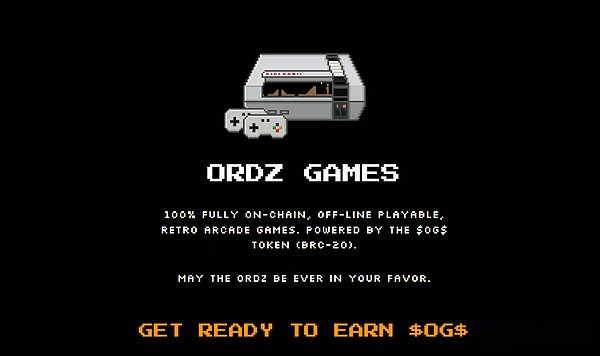
When I first saw Ordz Game (@OrdzGames) saying that it was a BTC-based fully on-chain game, I was also curious.In previous articles, we mentioned that inscriptions are isolated witness spaces that can upload any file to BTC, with the maximum size limit of 4M.As a result, domo uploaded “a piece of JSON format code for issuing coins”, which has long been a market of BRC20 billion US dollars.What if I upload a piece of game code to the chain?That’s exactly what Ordz does.
For web version mini games, when players visit the game web page, they will download the code to the browser’s local file, and then run the entire game directly in the browser. Therefore, “Game on the full chain of the inscription version” only needs to provide a downloaded game code.The online storage space is just for BTC’s isolation witness space. This is the DA layer.The principle is as follows:
-
Development: Mini games are usually developed using HTML, CSS, and JavaScript (JS).HTML is responsible for the structure of the page, CSS handles styles and layouts, while JavaScript is responsible for game logic, animations and user interaction.
-
Hosting: Developed game code and resource files (such as pictures, audio, etc.) will be uploaded to the BTC isolation witness space.This way, users can load the game by accessing specific URLs through their browser.Although the logic and operation of the game are completed entirely on the client (i.e. the user’s browser), the game’s files still need to be downloaded from the chain to the client.
-
Loading: When a user accesses a game’s web page, the browser downloads HTML, CSS, and JavaScript files.These files contain all or most of the code of the game.
-
Run: After the download is completed, the browser will parse HTML and CSS to build the structure and style of the page.At the same time, JavaScript code will be executed in the browser’s JavaScript engine.
-
Interaction: The user’s interaction with the game (such as clicks, drags, etc.) will be processed through JavaScript, and the game updates the game status and screen based on these interactions.Because these processes are completed on the user’s device, they are fast response and can provide a smooth gaming experience.
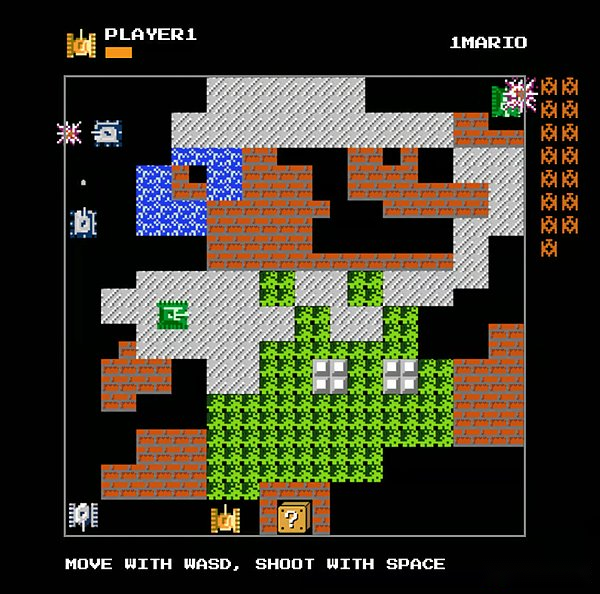
To sum up, although Ordz does upload all the game code to the chain, it strictly does not conform to the definition of “fully on-chain game”. After all, all the logic of the game is put off the chain and executed.However, as GameFi type inscription mini-games, it has its own unique side, and it has also issued its own inscription BRC20 token as utility token (ORDG).
Bitmap as a meta-universe map#
Bitmap (@bitmapdev) is known as the first meta-universe project in the Bitcoin ecosystem. It was proposed on Twitter on June 13, 2023 by Twitter user @blockamoto, and was subsequently followed and promoted by some media.Bitmap is based on Ordinals theory and Bitmap theory.Ordinal theory is to assign each sat a sequence number, and bitmap theory is also very simple. A block generated by Bitcoin every ten minutes is regarded as a map data to define some data formats based on the parameters of the data structure.The combination of the two means that each block is treated as a map NFT, and then the NFT is bound to a certain sat using ordinal.
Bitmap theory itself only stipulates two basic rules:
1. Each block is defined as a “region” (District), represented by the block height.
2. Each transaction in the block is defined as “pallet” (Parcel), and counts from 0 in order.
Then the so-called “inscribe” means uploading the serial numbers of the region and plots to the isolation witness space in the format and binding sat.For example, for blocks with a block height of 31209, you need to bind the text (31209.bitmap) to sat to declare ownership.For the fifth transaction in block 31209, you need to bind the text (5.31209.bitmap) to sat.But only the owner of “district” is allowed to engrave ownership of “parcel”.
Other subrules, including the meaning represented by input/output, the meaning represented by the number of block transactions, etc., can be defined separately by different projects, which is why 2D version map, 3D version map, and VR version map…
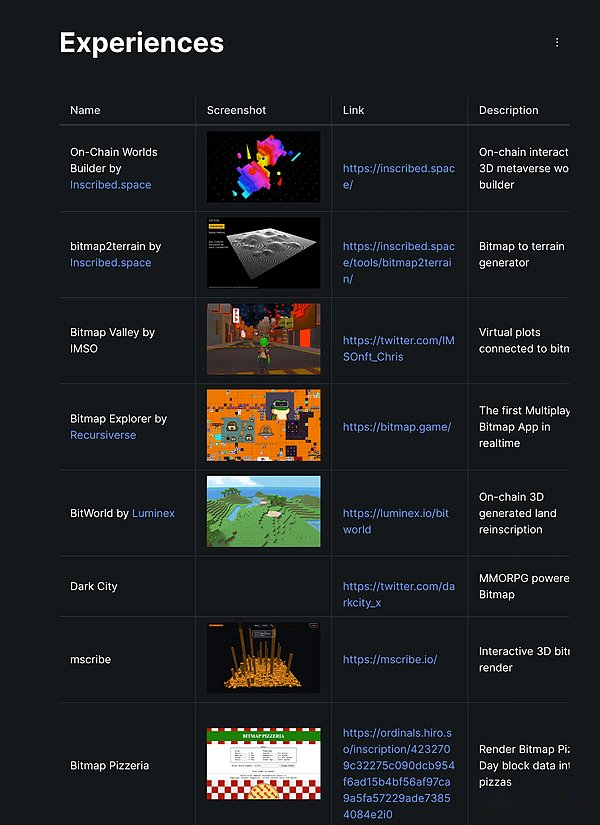
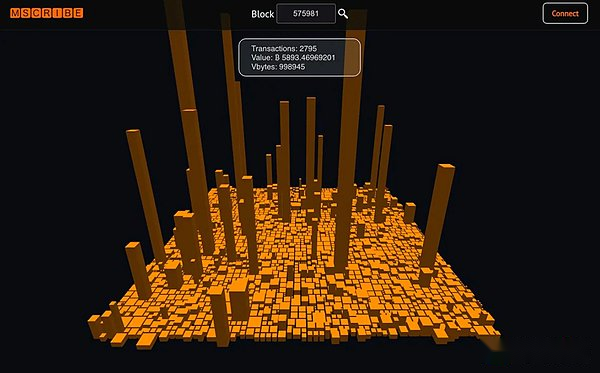
The well-known protocol BRC420 initially created the avatar and bitmap NFT interaction protocol (using recursive inscription technology and exploring the conversion of graph coins), forming the bitmap.game product, which is the most famous development team in the bitmap ecosystem.The team then created a recursive inscription avatar generation platform (rcsv.io) and BTC layer 2 network Merlin Chain, and the company name has also been changed to Bitmap Tech.So please note here that Bitmap Tech and Bitmap protocols are completely different.
During the Genesis Issuance stage, the total amount of Bitmap can be Mint is the height of Bitcoin blocks.When the Bitmap standard was released, there were more than 700,000 historical blocks. For historical blocks, users can freely choose to engrave them as long as they pay the miner’s fee.More than 700,000 historical blocks were registered within 2 months of the founder’s release.
The total amount of Bitmap is pegged to the current block of Bitcoin, and Bitcoin produces one block in about ten minutes.So the total amount is theoretically infinite.Every time Bitcoin generates a new block, there will be an additional bitmap that can be registered (according to the rules, only the inscribed registration initiated after block mining is valid), following the first come first served principle, and anyThe plain text ordinals inscription of a human inscribed block number.bitmap is a way to snatch ownership of this block.So 144 new blocks are mined and available for registration every day.Currently, mainstream NFT exchanges will also update the total BITMAP volume in real time.
In terms of total, bitmap NFT is not scarce, so the current hype is all about some special maps.for example,
1, Special number, similar to 888.bitmap
2. A map with special patterns was generated based on official visual data, similar to cryptopunk.
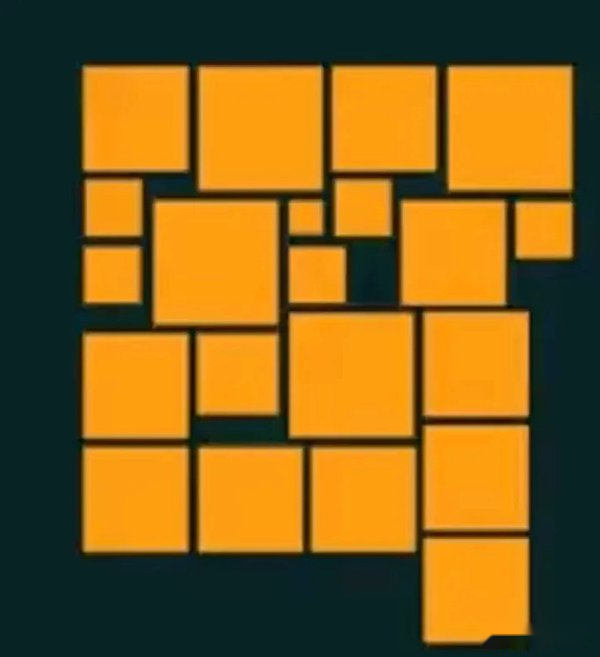
3. Blocks containing important historical reality, such as the Creation block, the pizza trading block, etc.
In terms of infrastructure, more exploration comes from front-end rendering based on block data.Several of the following figures:
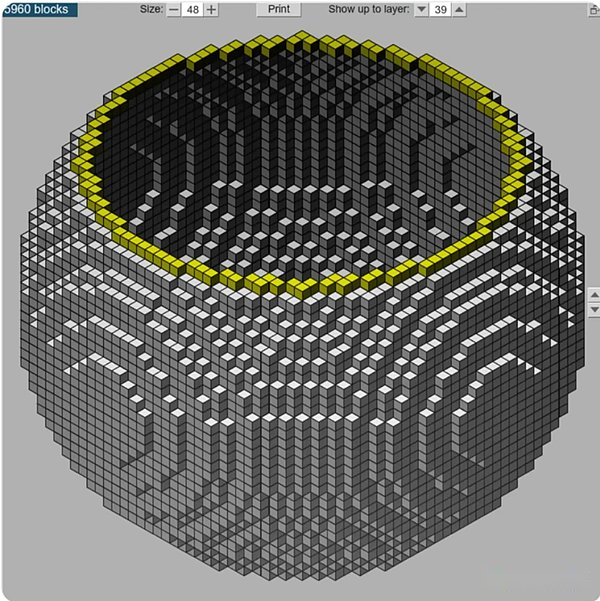
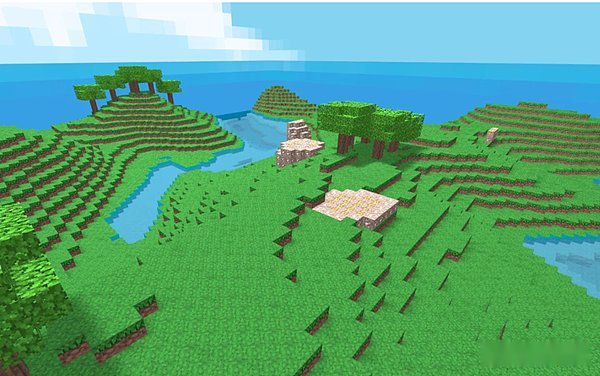
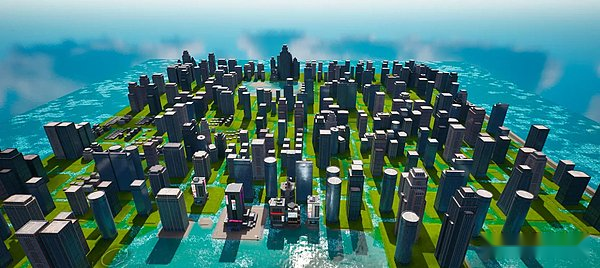
In summary, bitmap is actually an asset marking protocol. Through the Ordinal protocol and the bitmap protocol, the masterless asset “Bitcoin Block” is mapped into NFT, thereby activating the asset attributes of the block and generating circulation and collection value.
LOOT of Bitcoin Ecosystem#
If bitmap is entering the metaverse from the plot, then rootverse (@ordinals_root) and BRC1024 (brc1024_pro) are trying to enter the metaverse from the characters and equipment, and the gameplay is similar to LOOT.
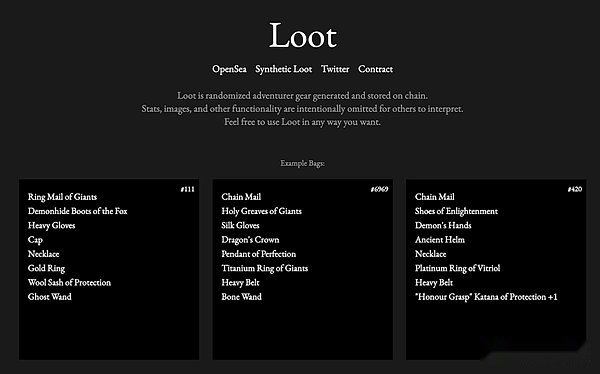
We are all familiar with Ethereum’s LOOT, which is a randomly combined text version of NFT. This set of text descriptions defines the attributes of a device, thus laying the basic rules of a metaverse, which others can use in theseBased on text NFT, composability is derived, such as 2D picture presentation, 3D picture presentation, story presentation, etc.
BRC1024 is similar in its overall form, which specifies some parameters to define the component (Component) of the metaverse, as shown in the figure below, indicating that ROOT There is a component called “charactor” in this metaverse, and its subcomponent is called “warrior”. This subcomponent is the largest.The number is 20,000. Elements are several attributes of this subcomponent. Some attributes even have multiple options. For example, the “skin color” attributes are white and copper.
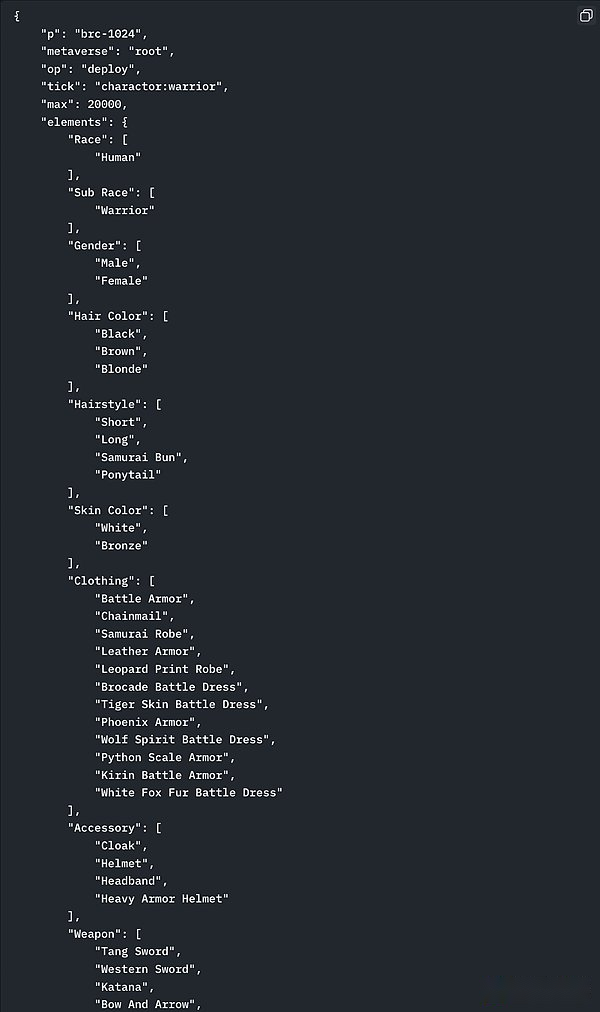
ROOT (official name Rootverse) is the first metaverse established by the project using BRC1024, which stipulates 21 tribes (that is, races and corresponding subraces). Each subrace has a different number, and players can cast it for free, totaling 21.Ten thousand characters NFT.As shown in the figure below:
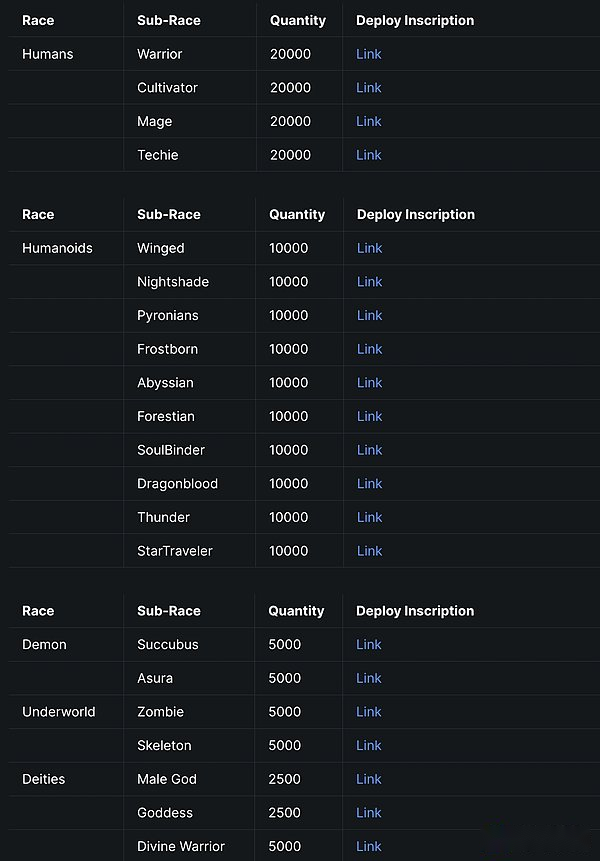
In summary, if BRC20 engraves the “code for issuing FT tokens” into the Isolated Witness Space to implement the FT code issuing, then BRC1024 engraves the “code for issuing the Metauniverse Components” into the Isolated Witness Space to implement the Isolated Witness Space to implement the Isolated Witness Space to implement the Isolated Witness Space to implement the Isolated Witness Space to implement the Isolated Witness Space to implement the Isolated Witness Space to implement the Isolated Witness Space to implement the Isolated Witness Space to implement the Isolated Witness Space to implement the Isolated Witness Space to implement the Isolated Witness Space to implement the Isolated Witness Space to implement the Isolated Witness Space to implement the Isolated Witness Space to implement the Isolated Witness Space to implement the IsolatedAnd ROOT engraves the component “character race”.This is the embodiment of the composability of the inscription.
Universal state machine for on-chain games#
With the map, characters and equipment of the metaverse, can we make a complete chain game based on BTC chain?If you only do the GameFi route that only works on assets (including NFT assets and FT assets), the current infrastructure is enough, but for more crypto native on-chain games (autonomous world), it is not enough.
Dojo of the Ethereum ecosystem first proposed the concept of “Provable Onchain Game”.Dojo is an on-chain game development framework.It is a community-built, verifiable game engine and toolchain for building on-chain games and autonomous worlds.Dojo allows verification of game state and calculations without large consensus schemes.Games written or run RISC-Zero in Cairo, Noir and other languages can run independently on a browser-like standalone zkVM, and the verifiable output ensures real execution.In other words, it means that off-chain uses efficient VMs for calculations, and the on-chain part only performs data verification to ensure the authenticity and effectiveness of the results, thereby realizing “detrust” and “decentralization”.
Redux Protocol (@AutonomousRedux) refers to Dojo’s verifiable concept of games on-chain, and borrows the Ordinal theory to implement the on-chain game development framework in the BTC ecosystem.Although the BTC chain block time is as long as 10 minutes and does not have smart contract function, to realize the on-chain game of the BTC ecosystem, you can only use off-chain calculations to verify the on-chain mode.

What’s interesting is that Redux extends the use scenarios of “inscription”.As we all know, the previous inscriptions were basically used to issue coins, either Ordinal NFT tokens or FT tokens like BRC20.Redux combines the Merkel tree with inscriptions and proposes the concept of state inscriptions.In fact, it is to model and store the characters and equipment attributes in the game in the Merkel tree, and ensure the data is immutable.As long as there is a change in one place, the root hash will change.
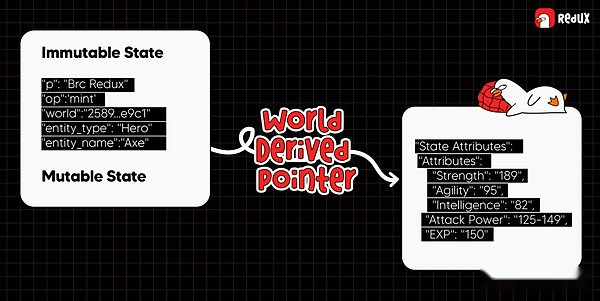
The specific method is to divide the state inscription into two parts, one part is an “immutable state”, such as the weapon’s health value, armor value, attack value, etc.This part is recorded in the form of an inscription on the BTC blockchain.Another part is “variable state”, such as the specific data of health, armor and attack values mentioned earlier, which will change as the game progresses.In this way, these data are calculated and processed by the off-chain indexer.”Inscribed” itself actually stores a pointer that points to the variable state set of the inscription.
The developer is responsible for building the basic framework of the world and its state inscriptions.This includes defining which states are immutable (static) and which states are mutable (dynamic), while establishing logic for users to interact with state inscriptions.The Redux protocol provides a running environment that allows developers to customize how players interact with state inscriptions.Players experience the game through interaction with the status inscription.
In terms of technical route, it’s a bit like Dojo or Paima.Dojo uses ZKP to create verifiable on-chain games, Paima uses NFT state compression to create verifiable on-chain games, while Redux uses state inscriptions (using Merkel tree) toAnother difference in making verifiable on-chain games is that Dojo treats Starknet as the DA layer, Paima treats its sovereign rollup as the DA layer, while Redux uses the DA layer of the BTC ecosystem.
To sum up, we found that the above projects are explored using the Ordinal protocol at different levels of the game: Ordz engraves the code of web games on the chain, and Bitmap maps BTC blocks as random data sources to map NFTs.ROOT is to engrave characters and equipment on the chain in code, while Redux is to engrave verifiable data from the state machine on the chain.If you have to compare with projects in the Ethereum ecosystem, Ordz compares TreasureDAO, Bitmap compares SandBox and DecentraLand, ROOT compares LOOT, and Redux compares Dojo and Argus.
References
https://www.panewslab.com/zh/articledetails/leqfrx2o.html
https://rcsv.gitbook.io/brc-420/
https://www.panewslab.com/zh/articledetails/22531q6583yt.html








